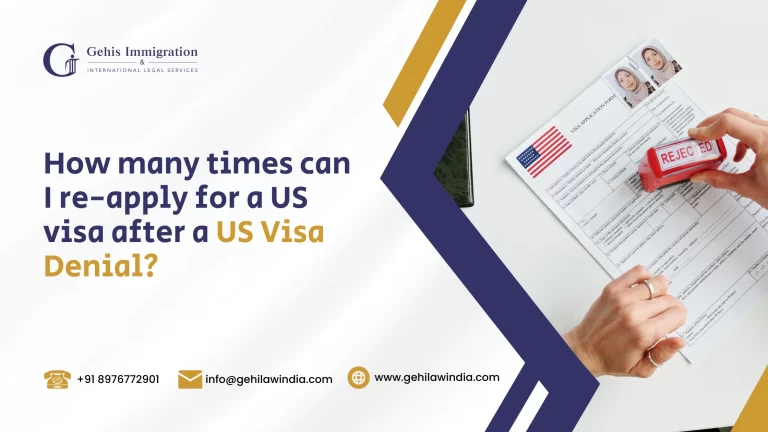The visa application process is crucial for those planning to enter the US for tourism, business, school, or work and if needed, re-apply for a US visa. Understanding the complex details of this procedure is important for ensuring a smooth and successful application. One important factor that applicants should be aware of is the likelihood of visa refusal and the need to understand reapplication options.
Visa denials may be frustrating, but knowing your re-application options is important for those who want to try again. Visa denials can be based on various factors, including a need for supporting documentation or concerns about the applicant’s intentions.
A thorough understanding of the U.S. visa application process and the options available after a denial is essential for prospective travelers. Being well-informed and prepared can significantly increase the chances of a successful visa application and entry into the United States.
What is U.S. Visa Denial?
Visa denials can be a challenging and frustrating experience for applicants. It is essential to grasp the common reasons behind visa denials and the potential consequences on future applications. Here are some of the aspects to consider:
- Failing to provide required documents or submitting incomplete or inaccurate information can lead to visa denials. It is necessary to carefully follow the application guidelines and present a comprehensive and accurate application.
- Consular officers often look for evidence of strong ties to the applicant’s home country to ensure their intention to return. Lack of proof of stable employment, property ownership, or family connections may result in a visa denial.
- The inability to demonstrate adequate financial resources to cover a stay in the U.S. can lead to visa denials. Consular officers want assurance that applicants can support themselves without relying on public assistance or unauthorized employment.
- People with criminal records or security concerns may encounter visa rejections, particularly when extensive background checks are needed.
- Giving false information or trying to deceive consular officers can result in instant visa denial and legal repercussions.
- Individuals with a history of overstaying visas, entering the U.S. illegally, or other immigration violations may encounter difficulties obtaining a new visa.
What are The Steps re-apply for a US visa after a US Visa Denial?
After experiencing a U.S. visa denial, taking immediate and informed steps to address the situation is important. Start by thoroughly examining the denial notice from the consular officer for crucial details on the rejection reasons. Take note of any instructions or suggestions provided in the notice. If the grounds for denial are unclear or legal intervention is deemed necessary, consider seeking guidance from an experienced immigration attorney. They can offer valuable insights into your case, assess the denial notice, and advise on potential legal remedies or appeals.
Understanding your rights and options is also a plus, and an attorney can assist in determining whether reapplication, filing a motion to reopen, or pursuing other legal avenues is the best course of action.
Analyze the reasons for the denial, addressing financial concerns or ties to the home country issues by gathering additional supporting documentation. Correct any errors or misunderstandings from the initial application, and if applicable, explore the possibility of eligibility for a waiver to overcome specific grounds of inadmissibility.
Taking these immediate steps is important to understanding the denial, seeking appropriate legal guidance, and preparing for future applications with a stronger case.
Re-apply application for a US visa Process For United States
The re-application process for a U.S. visa demands a methodical approach to increase the chances of a favorable outcome. Begin by meticulously reviewing the denial notice from the previous application and addressing and rectifying the issues raised by the consular officer. Update and refine all supporting documentation, ensuring accuracy and relevance to your current circumstances.
Complete the visa application form truthfully, paying attention to any changes in your situation since the last application. Submit the application online through the official channels and pay the required visa application fee. Schedule a visa interview at the U.S. embassy or consulate in your home country upon submission. Attend the interview prepared to address any questions about previous denials, providing honest and clear explanations while emphasizing positive changes and strong ties to your home country.
Throughout the process, honesty, transparency, and a genuine commitment to immigration laws are essential. Seeking professional guidance, especially if legal issues were involved in the previous denial, can enhance your preparedness for a successful re-application.
What Are The Waivers or Appeals in U.S. Visa?
After a US visa denial, individuals can consider waivers or appeals to address specific inadmissibility reasons. To pursue a waiver, it is imperative to identify the grounds of inadmissibility outlined in the denial notice related to a criminal record or health issues.
Visa categories have unique waiver options. Consulting an immigration attorney is crucial to assess eligibility and prepare well. On the other hand, considering an appeal depends on the nature of the denial, as not all cases are appealable.
Review denial notice, get legal advice to assess appeal merit, and meet filing deadlines for compliance. Showing how you fixed past issues and providing strong proof are key in waiver applications and appeals. An experienced immigration attorney’s guidance is crucial for navigating processes and increasing success chances based on individual circumstances.
Final Word
The U.S. visa application process requires a thorough understanding of the procedures and potential challenges. Things to remember include the importance of accurate documentation, addressing specific reasons for visa denials, and seeking professional guidance when needed. The re-apply application for a US visa Process application process involves meticulous preparation, from reviewing denial notices to updating documentation and submitting a well-crafted application. Understanding waiver options and the potential for appeals provides additional avenues for overcoming obstacles. Each step demands attention to detail and a commitment to presenting a compelling case for entry into the United States.
Visa denials are manageable obstacles but opportunities to learn, adapt, and strengthen future applications. Stay strong, act on denial feedback, and get help to improve your chances of success. Diligence in preparing accurate, complete, and updated documentation and persistence in addressing any challenges can lead to a positive outcome. To succeed in the US visa process, applicants need determination, resilience, and commitment to navigate complexities.






